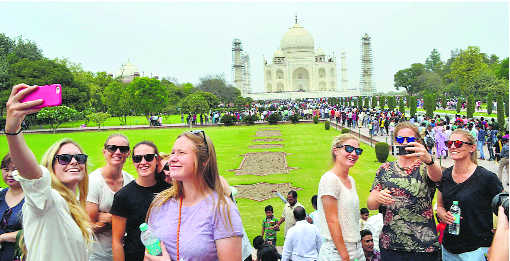Nonika Singh
Why can't India tap its tourism potential? Now, this is a contentious question that has not just piqued policy planners but also the average Indian who sees no reason why India shouldn't be a 'must visit' country on the itinerary of an ardent globetrotter. What India offers to tourists both in terms of variety and range perhaps few nations can match. The Make in India initiative launched by Prime Minister Narendra Modi in September 2014 may or may not become a reality, but our tourism attractions are pure 24 carat, made in India cent per cent.
If France has its Palace of Versailles, India has the iconic Taj Mahal, if Italy has its Leaning Tower of Pisa, the Qutab Minar is no less majestic. India matches the world's resplendence minaret by minaret. Deserts to coastlines; wildlife sanctuaries to ancient temples; natural bounty or man-made wonders, nothing is in short supply.
Yet India remains at the 40th position out of 136 countries, having received only nine million international arrivals in 2016. What to talk of countries around the world, even as compared to individual cities such as Paris or Barcelona, the inflow of tourists in India is far, far less.
For the naysayers, however, let it be said that there has been a substantial growth each year. India is the seventh largest tourism economy in terms of GDP and it is likely to become the third largest by 2028.
A 2018 impact report by the World Travel & Tourism Council (WTTC) not only brings this good news on its wings but also that it will offer as many as 10 million additional jobs by 2028. The World Economic Forum's white paper on India's tourism industry too outlines a silver lining — the country's $20 billion tourism opportunity.
Of course, there is a catch to this wishful thinking. The road to becoming the world's fastest growing economy in the tourism sector is not easy. It requires more than one proactive step. Be it natural resources, history, art and heritage, we have it all in place, more stupendous and glorious than any country can ever hope to possess. Yet what doesn't fit into our biggest USP is the basics of the lowest common denominator that most countries take for granted, especially those which aspire to be tourist hubs. Cleanliness, safety, connectivity are issues that stand out like a sore thumb on our tourist map where 36 world heritage sites gleam with pride.
Gloria Guevara, President and CEO, WTTC, pinpoints the single biggest area of improvement for travel and tourism in India as infrastructure, on which the government is caught napping all too often.
It isn't as if tourism is off the government's radar. Tourism Policy 2015 aimed to position tourism as a priority on the national and economic agenda. The new avatar of the Incredible India campaign, its 2.0 counterpoint, launched in 2017 rightly focused on India's spiritual and wellness traditions, both of which are inimitable and unique to our civilisation. But when it tried to push Yogi Adityanath's Gorakhpur, home to the Gorakhnath Math and Ayodhya the birthplace of Lord Ram as global destinations, it did send some wrong signals.
Spiritual tourism can't be confined to one particular religion. Just as an advisory can't become an alibi for not providing safe passage to women tourists. When the minister for tourism proclaimed that "for their own safety, women foreign tourists should not wear short dresses and skirts ...Indian culture is different from the western", he might have thought he was being rather sagacious and pragmatic. But fallacious messages such as these, already finding an echo in the cautionary guidelines of western nations, end up denting India's image furthermore.
The image also takes a beating when filth-ridden and potholed roads and unscrupulous travel agents greet foreign travelers.
To be fair, the tourism scenario today is no longer as bleak, but if it really has to become as rosy as the WTCC has predicted, there can be no room for complacency. Just as India's tourism potential has many branches — from medical to experiential to adventure to heritage — it has many roadblocks too which need to be evened out.
Magical and mystical India will work only if the simple wherewithal is in place. The Swachh Bharat Abhiyaan has many spinoff benefits but the most tangible ones are likely to be seen in the tourism sector. Tourism drives economy in many ways. From its multiplier effect on employment to its foreign exchange earnings, it's not simply about building brand India, though that is equally important.
Athithi devo bhavo isn't just a truism… the country may have done away with its most visible high profile brand ambassador, actor Aamir Khan, but it's spirit and essence can neither be forgotten nor compromised. Just throwing the one-liner India as a Must Experience destination in its refurbished campaign will not make India the most favoured tourist hub. Roping in an international celebrity to drive the Incredible India 2.0 campaign per se is fine but the real driver has to be innovative and fresh strategies harnessing and putting technology to best use.
Opening up the North-East, rich in natural habitat and wildlife, is one such move. Announcing new tourist circuits is easy, but green-lighting the same in an efficient and enticing manner which both beckons and woos tourists is a different ballgame. Come, seek, explore… before that is told to tourists across the globe, there is need to scrutinise and work on the collective synergy. Incredible India just can't be a poster or audio-visual campaign… it must translate into reality.
nonikasingh1@rediffmail.com
Unlock Exclusive Insights with The Tribune Premium
Take your experience further with Premium access.
Thought-provoking Opinions, Expert Analysis, In-depth Insights and other Member Only Benefits
Already a Member? Sign In Now










